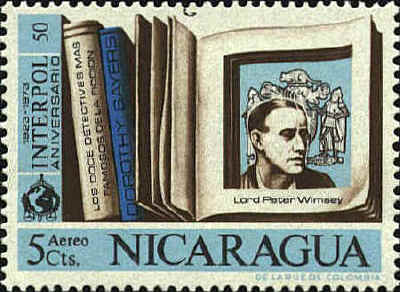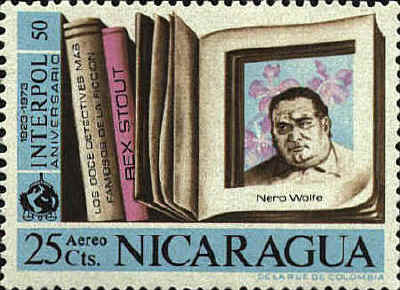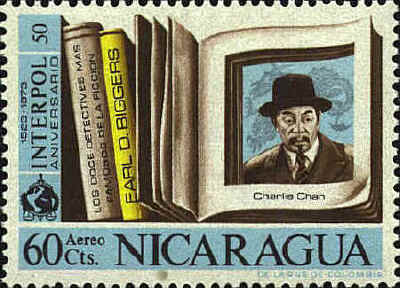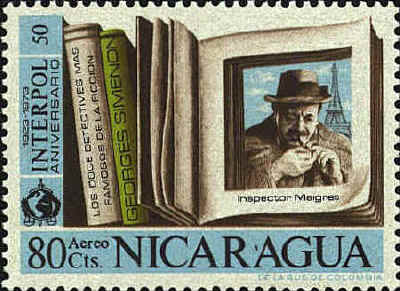|
This
set of stamps of the twelve most famous fictional detectives was
issued in 1972 to celebrate the 50th Anniversary of Interpol,
1923-1973. When the Sandanistas came to power in 1979 they apparently
destroyed all the stamps issued by the Samoza government and printed
their own. So, the set is not especially easy to acquire. With the
exception of Georges Simenon's Maigret, all the detectives are English
speaking. The following paragraphs are translations of inscriptions in
Spanish on the back of each stamp on top of the gum.
The
hero of Dorothy L. Sayers first police novel, Whose Body?
(1923), was a detective called Lord Peter. Later the well-known
personage of Lord Peter Wimsey reappeared in Strong Poison
(1930) and in The Nine Tailors (1934). Thin, good-looking,
sporting a monocle, Wimsey was the perfect aristocratic
detective—elegant and excellent. There was something in his
aristocratic nature which led him to try and hide his talents as an
investigator, and he was one of the only detectives who found time to
marry.

Along
with Dashiell Hammett, Raymond Chandler was the main proponent of the
“hard-boiled” school of fictional detectives. His detective hero was
Philip Marlowe, who appeared for the first time in The Big Sleep
in 1939. In his own words, Chandler tried to create in Marlowe “a man
complete and common but exceptional...a man of honor.”

With
the creation of Sam Spade, Dashiell Hammett founded the “hard-boiled”
school of detective fiction. Spade’s most famous adventure was The
Maltese Falcon (1928), a classic detective novel.
A Pinkerton ex-detective like his creator, Spade’s
approach to crime was direct and honest. In a milieu which mixed
violence and treacherous villains, existing outside of normal society,
Spade was an intruder who belonged neither to the real world nor that
which he was involved in.

Perry
Mason, the defense counsel detective with the incredible success rate
was introduced in 1932 with The Case of the Velvet Claws. The
novels of Mason are interesting for their detailed attention to legal
points, scientific forensic medicine and criminology, a world Gardner
himself was familiar with, having practiced law for twenty years.

This
enigmatic and elephantine bloodhound of Rex Stout appeared for the
first time in the novel Fer-de-Lance (1934). Since then, Nero
Wolfe has continuously impressed readers of detective fiction as one
of the unique personages of this genre.
He is a genius of extraordinary size who detests
leaving his home, is dedicated to solving crimes, cultivating
award-winning orchids, and drinking beer. In accordance with the
popular image of geniuses, Wolfe is presumably of bad character. He is
not a hero who understands himself, but always a fascinating one.
Wolfe’s stories also contain the presence of one of the agitated
“Doctor Watsons” of the detective novel, Archie Goodwin.

C.
Auguste Dupin appeared for the first time in “The Murders in the Rue
Morgue”, written by Edgar Allan Poe (1941). With this story Poe
created the first fictional detective. “The Purloined Letter” and “The
Mystery of Marie Roget” are two other Dupin stories.
Dupin was an
outlandish romantic who inhabited candle-lit quarters in Paris. He was
poor but of noble lineage, very experienced, a great smoker who wore
green-tinted glasses. He solves his crimes stunningly, using pure
analytical reasoning.

Ellery
Queen, who appeared for the first time in "The Roman Hat Mystery,"
(1929) was invented by two cousins, Frederic Dannay and Manfred Lee.
Ellery Queen serves as much as investigator as author.
He can entertain his reader by relating his own adventures or those of
his father, retired Inspector Richard Queen, of the New York Police
Department. Like a bloodhound, Queen is a private investigator who
works from his apartment on West 87th Street in New York. His stories
are famous for their realistic approach to deduction and the full
dialogues of the colorful and amusing personages who abound in them.

A short
story collection The Innocence of Father Brown (1911) began the
career of one of the most unlikely fictional detectives. Father Brown,
the creation of G. K. Chesterton, always used his almost supernatural
ability to divine the culprit by pure intuition. Chesterton explained
that during the time he served as a rural curate, Brown had obtained
an ample knowledge of the forms of human evil, and in this way it was
possible for him to use his sixth sense to solve crimes.

It is
said the Earl Derr Biggers was tired of the sinister and evil image of
Orientals in detective novels, and in retaliation he created his good
and affectionate detective Charlie Chan. Chan debuted in the novel
The House without a Key (1925).
Chan was a Chinese-Hawaiian-American, who approached
his cases with a patient Eastern calm and worked to understand the
characters of the people he jeopardized. He was distinguished by his
quoting of Confucius and his ever-present "Number One Son."

Maigret
has been called by his creator “the mender of destinies.” He is a
police officer, but much more, a humanist and philosopher than agent
of the law. For Maigret what matters is the criminal and not the
crime. In his memoirs, Maigret explains to the reader that he first
planned to become a doctor and certainly he resembles more a family
doctor than a policeman., His hat, pipe and headquarters in the Quai
d’Orfèvres are known by the majority of readers of police stories
today. Simenon may well pass into history as the most prolific writer
of the 20th century.

This
small Belgian with the egg-shaped head appeared for the first time in
Agatha Christie’s The Mysterious Affair at Styles in 1920. Hercules
Poirot reached international fame in 1926, when The Murder of Roger
Ackroyd was published. The solution of this mystery, of the narrator
as prosecutor, originated a violent debate in the world of the mystery
novel. The popularity that Poirot received then has continued. His
tiny “gray cells” are legendary for their exactitude. Poirot is
classified as belonging to the system of intuition, using the
theoretical approach instead of the scientific for deduction.

Arthur
Conan Doyle, creator of the most famous fictional detective,
introduced Sherlock Holmes for the first time in A Study in Scarlet
(1887). Like his predecessor Dupin, Holmes was a personage of reserved
character, whose extraordinary powers of reasoning and observation
were his elementary means of deduction. Holmes was constantly
accompanied by the officious and always faithful Watson who gave the
enhancement of caution to his infallible detective. Holmes’ hooked
nose, deer-stalker’s cap, meerschaum pipe and violin are some of his
unique identifying characteristics.

 |
